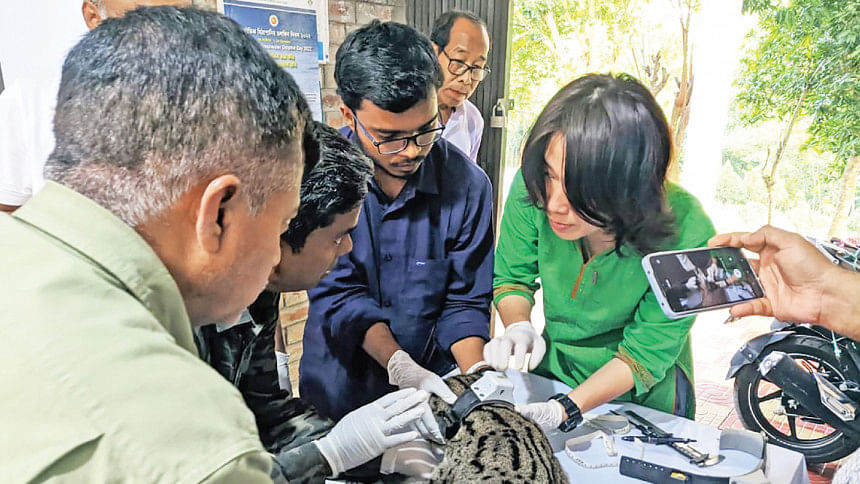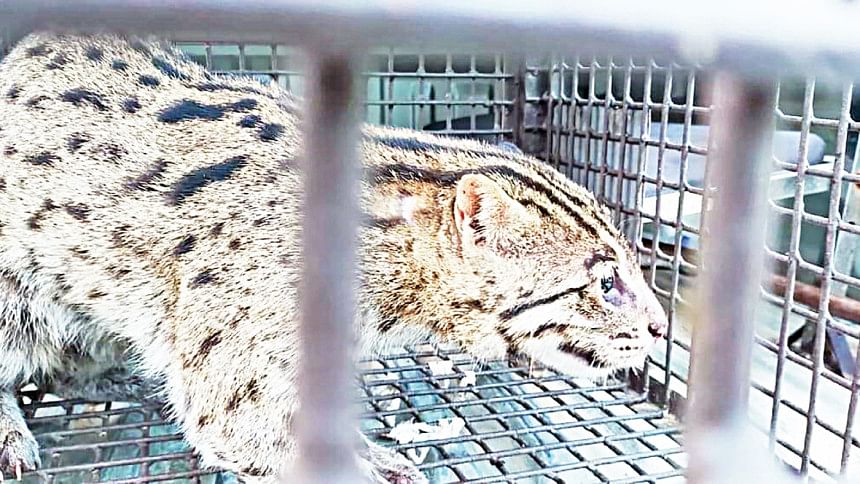Goodwill to save the misunderstood cats

With an olive-grey coat decorated with black spots and stripes, fishing cats have fascinated wildlife enthusiasts for a long time. Unlike other felines, the fishing cat, Prionailurus viverrinus, approximately twice the size of a house cat, is an expert swimmer and loves to hunt in the water. They have short tails (relative to other cat species) and small feet, with partially webbed paws.
Locally, they are called "mecho bagh", although they look more like small leopards than tigers. This name makes them misunderstood, and although they are harmless, humans often catch and kill them.

Globally, this species can be spotted in Bangladesh, Pakistan, Sri Lanka, Nepal, Myanmar, Thailand, Cambodia, and India's West Bengal. In Bangladesh, it is found across the country in discontinuous populations.
After years of neglect, the plight of the fishing cat has finally caught the attention of concerned government bodies in Bangladesh. Earlier, the standard protocol for rescuing these cats was to release them into protected forests. Unfortunately, this often resulted in their untimely deaths due to their inability to adapt to the new environment.
Thankfully, there has been a shift in approach in recent years, with rescued fishing cats now being released back into their original habitats. This new strategy has proven successful, with rescued cats adapting well and thriving in their natural environments.
And now, a new development has occurred.
The Department of Wildlife Management and Nature Conservation, on the evening of March 26, placed a satellite collar on the neck of a rescued fishing cat and released it at Officebazar area in Moulvibazar's Sadar union, from where it was originally rescued.
They have named the cat "Swadhin", which means free in Bangla.
"With this innovative technology, conservationists can observe the cats' migration patterns, habitat preferences, and breeding locations, providing critical information to protect the species and prevent further harm," said Rezaul Karim Chowdhury, former divisional forest officer of Wildlife Management and Nature Conservation Department in Sylhet.
Moreover, through data analysis, the initiative aims to break the stigma surrounding the fishing cat and educate local communities on the true nature of this feline. By showcasing their dietary habits and demonstrating their preference for habitats beyond human reach, the project hopes to shift attitudes and foster a greater appreciation for the fishing cat's unique role in the ecosystem, he added.
SCARY STATS
The fishing cat is facing a threat to its survival due to increasing human-cat conflicts, according to a study conducted by researchers from Dhaka University. From 2005 to 2021, the researchers collected 564 reports of 361 incidents of human-cat conflict.
Of these incidents, 395 adult and 170 juvenile or mixed breed cats were involved, and 160 cats died in various incidents. Shockingly, male cats were misrepresented in about 83 percent of the cases, as tigers and leopards.
"The conflicts see the highest number during winter, and since 2016, there has been news of a new fishing cat-human conflict in the media every 15 days. These conflicts are caused mainly by the destruction of wetlands, which are the natural habitat of fishing cats, and their resulting increased proximity to humans," said Muntasir Akash, assistant professor of zoology at Dhaka University.
In about 50 percent of cases, humans have shown retaliatory behaviour towards fishing cats on sight, while only 25 percent of the conflicts were due to cats eating poultry.
The study also revealed that chasing and attacking male cats were observed in about 60 percent of cases, while stray cats were caught in traps in 20 percent of cases.

 For all latest news, follow The Daily Star's Google News channel.
For all latest news, follow The Daily Star's Google News channel. 



Comments